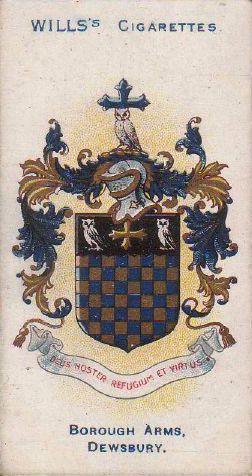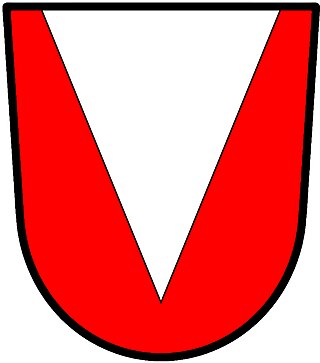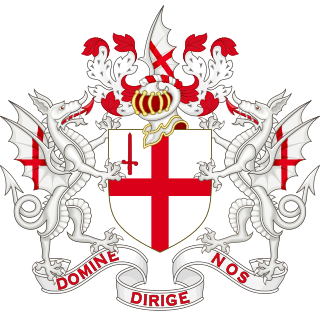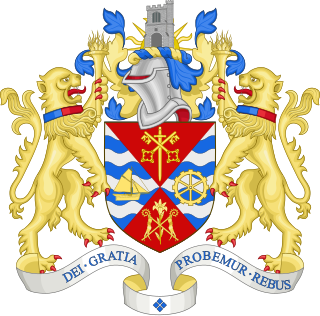
In heraldry, an ordinary is one of the two main types of charges, beside the mobile charges. An ordinary is a simple geometrical figure, bounded by straight lines and running from side to side or top to bottom of the shield. There are also some geometric charges known as subordinaries, which have been given lesser status by some heraldic writers, though most have been in use as long as the traditional ordinaries. Diminutives of ordinaries and some subordinaries are charges of the same shape, though thinner. Most of the ordinaries are theoretically said to occupy one-third of the shield; but this is rarely observed in practice, except when the ordinary is the only charge.

The coat of arms of Sunderland is the official heraldic arms of the City of Sunderland in England.

Oldham was, from 1849 to 1974, a local government district in the northwest of England coterminous with the town of Oldham.

The coat of arms of Kirklees Metropolitan Borough Council was granted on 24 June 1974. This was just a few months after the district of Kirklees was created as part of the new metropolitan county of West Yorkshire. It is rarely used by the Council who, until 2007, preferred to use a logo that is based upon the arms.

The Coat of arms of Leeds City Council derives its design from the seventeenth century. In 1662 the Borough of Leeds received a new charter which created the office of mayor, and the arms seems to date from about this time as they incorporate part of the arms of the first mayor. These arms were recorded at the heraldic visitation of Yorkshire in 1666. By the time that the borough was reformed by the Municipal Corporations Act 1835, silver owls had been added both as crest above the shield, and as supporters on either side. These additions were not authorised, however, and in 1920 application was made by Leeds County Borough Council to the College of Arms to have these additions officially granted. In the following year the grant of crest and supporters was made, with the colouring of the owls altered to "proper", or natural colourings. Gold ducal coronets were added to the supporters for further heraldic difference.

The Coat of Arms of Bradford City Council was granted in 1976. The present City of Bradford was created in 1974 by the Local Government Act 1972 and is one of five metropolitan boroughs of West Yorkshire. The 1976 arms are based on those of its predecessor, the County Borough of Bradford.

The coat of arms of Dewsbury was the official symbol of the county borough of Dewsbury in the West Riding of Yorkshire. The county borough was abolished in 1974 under the provisions of the Local Government Act 1972 and replaced by Kirklees Metropolitan Council and West Yorkshire Metropolitan County Council.

The coat of arms of Wigan Metropolitan Borough Council was granted by the College of Arms in 1974.

In heraldry and heraldic vexillology, a blazon is a formal description of a coat of arms, flag or similar emblem, from which the reader can reconstruct the appropriate image. The verb to blazon means to create such a description. The visual depiction of a coat of arms or flag has traditionally had considerable latitude in design, but a verbal blazon specifies the essentially distinctive elements. A coat of arms or flag is therefore primarily defined not by a picture but rather by the wording of its blazon. Blazon is also the specialized language in which a blazon is written, and, as a verb, the act of writing such a description. Blazonry is the art, craft or practice of creating a blazon. The language employed in blazonry has its own vocabulary, grammar and syntax, which becomes essential for comprehension when blazoning a complex coat of arms.

The Municipal Borough of Middleton was, from 1886 to 1974, a municipal borough in the administrative county of Lancashire, England, coterminous with the town of Middleton.

In heraldry, a pile is a charge usually counted as one of the ordinaries. It consists of a wedge emerging from the upper edge of the shield and converging to a point near the base. If it touches the base, it is blazoned throughout.
Cornish heraldry is the form of coats of arms and other heraldic bearings and insignia used in Cornwall, United Kingdom. While similar to English, Scottish and Welsh heraldry, Cornish heraldry has its own distinctive features. Cornish heraldry typically makes use of the tinctures sable (black) and or (gold), and also uses certain creatures like Cornish choughs. It also uses the Cornish language extensively for mottoes and canting arms.
Coats of arms and seals of the County and Duchy of Cornwall, the Diocese of Truro, and of Cornish boroughs and towns.

The coat of arms of the City of London is the official coat of arms of the City of London, England, which is one of a number of cities and boroughs in Greater London.

The coat of arms of the London Borough of Barking and Dagenham is the official coat of arms of the London Borough of Barking and Dagenham, granted on 1 September 1965.

Coat of arms of the London Borough of Bexley is the official coat of arms of the London Borough of Bexley, granted on 20 May 1965.

The coat of arms of the London Borough of Camden were granted on 10 September 1965. The borough was formed by the merger of three former boroughs, namely the Metropolitan Borough of Hampstead, the Metropolitan Borough of Holborn and the Metropolitan Borough of St. Pancras, from whose arms elements were utilised in the arms of the new borough.

The coat of arms of the London Borough of Hackney is the official heraldic arms of the London Borough of Hackney, England. The coat of arms were granted on 25 July 1969.

The coat of arms of the Borough of Chorley was granted along with borough status in 1882.
















